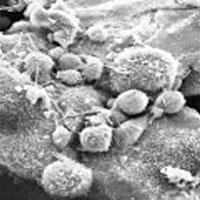Scientists have discovered a way to dramatically boost the numbers of stem cells used for bone marrow transplants.
The technique uses stem cells known as CD34 cells, which are present in the blood of a developing baby.  A small number of them can be harvested from the umbilical cord immediately after a baby is delivered and, in recent years, companies have begun to provide storage services so that parents can preserve these cells in case their child ever needs a source of stem cells in the future. They can, for instance, be used as a bone-marrow transplant if the individual develops leukaemia later.
A small number of them can be harvested from the umbilical cord immediately after a baby is delivered and, in recent years, companies have begun to provide storage services so that parents can preserve these cells in case their child ever needs a source of stem cells in the future. They can, for instance, be used as a bone-marrow transplant if the individual develops leukaemia later.
Unfortunately, the numbers of cells that can be harvested like this is often only about 10% of the number needed for a successful bone marrow transplant. The obvious solution - trying to grow the cells in a dish - invariably causes them to lose the ability to behave as stem cells, rendering them useless. But now, writing in Nature Medicine, researcher Colleen Delaney, who's based at the Fred Hutchinson Cancer Research Centre in Seattle, together with colleagues at the University of Washington, has found a way to expand the numbers of these stem cells without causing them to lose their important stem cell-like behaviour.
The researchers have found that a key chemical signal, called Notch1, which normally helps to control the growth of bone marrow cells in the body, can be used to induce CD34 stem cells to grow in the dish. Critically, Notch1 makes the cells divide, increasing their numbers up to 164-fold, but without sacrificing their key stem cell properties.
Using this technique, the team showed, initially in mice and then in a small group of humans with life-threatening leukaemias, that cells produced this way can be used for bone marrow transplantation.
Most importantly, they found in the human subjects that the transplanted bone marrow "took" and began to produce new blood cells ten days sooner than patients treated with conventional bone marrow transplant techniques. This could make a significant impact on survival which, previous studies have shown, is strongly linked to how quickly a patient recovers the ability to begin producing new blood and immune cells again following a bone marrow transplant.










Comments
Add a comment